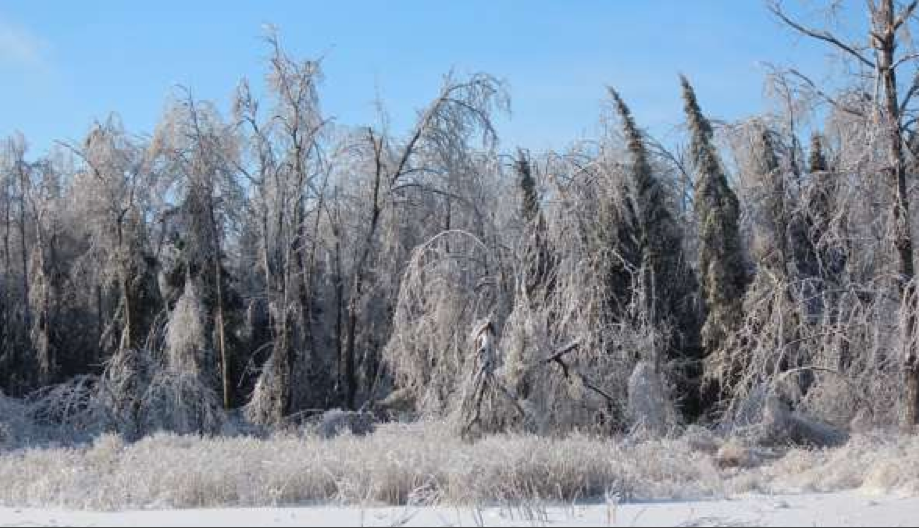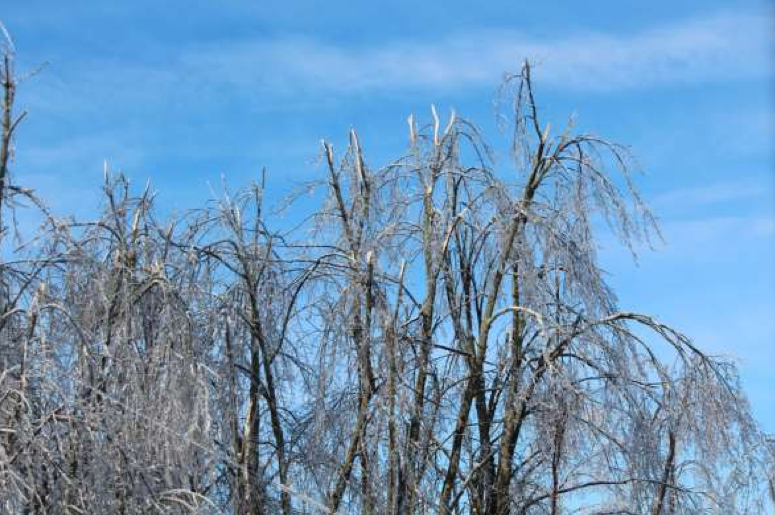by W.D. McIlveen
There is little doubt that the winter solstice of 2013 will be one to remember for a long time to come. The situation was certainly not unprecedented for some freezing rain occurs in most winters. And the amount of rain that fell was less than that that which happened in the great ice storm of 1998 in Ontario. Yet the extent of area that was impacted and the number of people affected in 2013 might well be much greater. More time will be required for a proper assessment of the effects to be completed but the following is a preliminary set of observations from our area.

The storm was not a single event but two similar storms that followed the same track about two days apart. As it turns out, our area fell zone where the ambient temperatures were too low for the precipitation to fall as rain and too warm to fall as snow. As measured at the Pearson Airport, the amount of rain that fell on December 20 was 8.6 mm followed by 16.6 mm and 13.6 mm on the two days following respectively for a total of 38.8 mm. The distribution of the rainfall as shown in the attached map obtained from the CBC weather forecast indicates that the highest amount of rain was expected further west of Toronto so it would not be unreasonable to expect that we experienced well over 40mm. By comparison, the amount of rain reported during the 1998 storm was 85 mm in Ottawa, 73 mm in Kingston, 108 in Cornwall and 100 mm in Montreal.

The net result was an accumulation of a thick layer of ice on all exposed surfaces. The thickness on tree branches was observed to be at least 30 mm on the upper side surfaces. Considering the possibility of dripping, three dimensional distribution and multiple of layers branches, it is conceivable that the true amount of rain here was perhaps double that measured at Toronto. It appeared that the amount of damage above the Niagara Escarpment was greater than that at lower elevations.
The ice that accumulated resulted in a huge weight stresses on the tree branches. Although many factors are involved, the stress resulted in a great amount of branch breakage. It was estimated that about a quarter of the tree canopy in Toronto was damaged by the ice. Falling branches caused extensive damage to power lines and many support poles were broken. It took up to ten days to get all power restored. Fallen branches also blocked sections of roadways.

There are additional factors to consider including species involved and branching patterns of individual trees but two patterns were evident in the breakage. Large branches that broke were often suffering from some previous damage or decay, especially when the branch crotches were narrow. The second thing was the there were huge numbers of smaller branches that were broken, usually in the upper crown. The branches affected exhibited a reasonable consistency in diameter where the break occurred. This was at branch diameters of 6 to 10 cm. It seems reasonable to conclude that the wood strength at diameters greater than this were able to support the load of ice. At lower diameters, the individual twigs were flexible enough to withstand the ice. But at the indicated diameters, the branches supported a certain combination of number of twigs of a particular length such that the critical load-bearing strength of the supporting branch was exceeded and so it broke. A very similar pattern was evident in Eastern Ontario following the storm of 1998. When trees did not break, the trunks bent under the load. In some cases, species such as poplars and birch bent to a high degree, sometimes involving trunk diameters that were well in excess of what one might expect as possible.
Despite the obvious damage, especially where entire trees had to be removed, the long-term impact likely to be limited. Broken branches will undoubtedly reduce the rate of growth of the trees for a short period of time. It is to be expected that broken branches will create potential infection courts for decay to become established. Studies of this kind were initiated following the storm of 1998 but the results of those studies have not been widely distributed. When one travels through eastern Ontario, it is becoming increasingly difficult to see broken branches as the branches lower on the trunk have grown and surpassed the point of the break.
While we cannot say with certainty that a similar storm will or will not occur again in the near future, the possibility for such a storm will always remain. While it may be counter intuitive that an ice storm resulted from global warming, that may in fact be the case. Global warming is expected to alter the frequency and severity of storms but storms can occur in all seasons. It will not be possible to attribute any individual storm to climate change. All we will be able to do is observe that more storms occur and deal with them as they arise.
